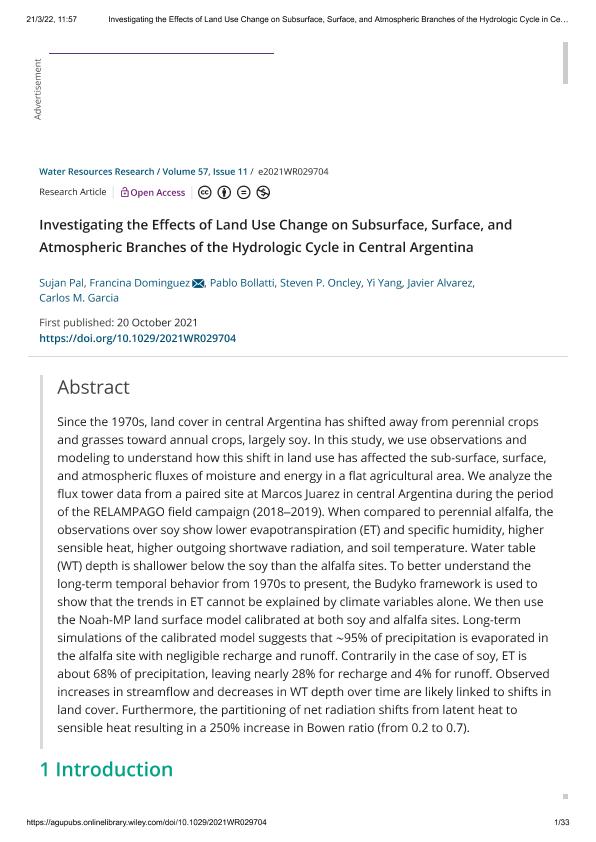Artículo
Investigating the effects of land use change on subsurface, surface, and atmospheric branches of the hydrologic cycle in central Argentina
Pal, Sujan; Dominguez, Francina; Bollatti, Pablo; Oncley, Steven P.; Yang, Yi; Alvarez, Javier ; Garcia Rodriguez, Carlos Marcelo
; Garcia Rodriguez, Carlos Marcelo
 ; Garcia Rodriguez, Carlos Marcelo
; Garcia Rodriguez, Carlos Marcelo
Fecha de publicación:
20/10/2021
Editorial:
American Geophysical Union
Revista:
Water Resources Research
ISSN:
0043-1397
e-ISSN:
1944-7973
Idioma:
Inglés
Tipo de recurso:
Artículo publicado
Clasificación temática:
Resumen
Since the 1970s, land cover in central Argentina has shifted away from perennial crops and grasses toward annual crops, largely soy. In this study, we use observations and modeling to understand how this shift in land use has affected the sub-surface, surface, and atmospheric fluxes of moisture and energy in a flat agricultural area. We analyze the flux tower data from a paired site at Marcos Juarez in central Argentina during the period of the RELAMPAGO field campaign (2018?2019). When compared to perennial alfalfa, the observations over soy show lower evapotranspiration (ET) and specific humidity, higher sensible heat, higher outgoing shortwave radiation, and soil temperature. Water table (WT) depth is shallower below the soy than the alfalfa sites. To better understand the long-term temporal behavior from 1970s to present, the Budyko framework is used to show that the trends in ET cannot be explained by climate variables alone. We then use the Noah-MP land surface model calibrated at both soy and alfalfa sites. Long-term simulations of the calibrated model suggests that ∼95% of precipitation is evaporated in the alfalfa site with negligible recharge and runoff. Contrarily in the case of soy, ET is about 68% of precipitation, leaving nearly 28% for recharge and 4% for runoff. Observed increases in streamflow and decreases in WT depth over time are likely linked to shifts in land cover. Furthermore, the partitioning of net radiation shifts from latent heat to sensible heat resulting in a 250% increase in Bowen ratio (from 0.2 to 0.7).
Palabras clave:
Hydrometorology
,
Hydrology
,
Land use change
Archivos asociados
Licencia
Identificadores
Colecciones
Articulos(IDIT)
Articulos de INSTITUTO DE ESTUDIOS AVANZADOS EN INGENIERIA Y TECNOLOGIA
Articulos de INSTITUTO DE ESTUDIOS AVANZADOS EN INGENIERIA Y TECNOLOGIA
Citación
Pal, Sujan; Dominguez, Francina; Bollatti, Pablo; Oncley, Steven P.; Yang, Yi; et al.; Investigating the effects of land use change on subsurface, surface, and atmospheric branches of the hydrologic cycle in central Argentina; American Geophysical Union; Water Resources Research; 57; 11; 20-10-2021; 1-33
Compartir
Altmétricas



